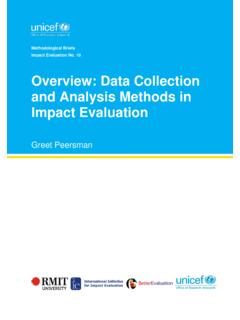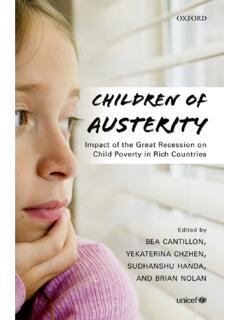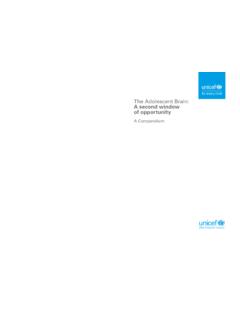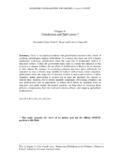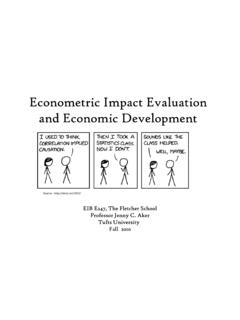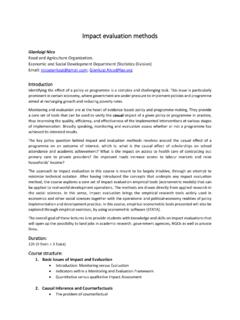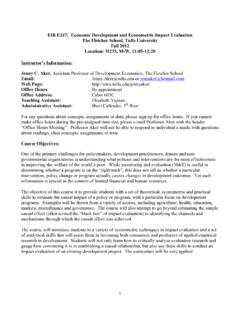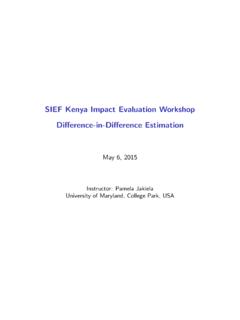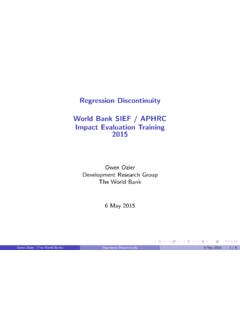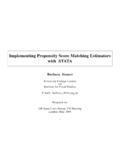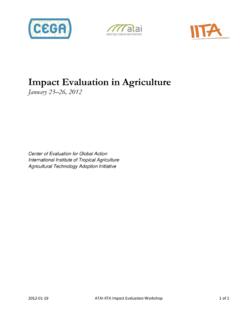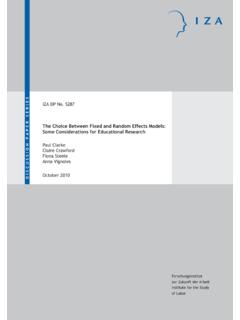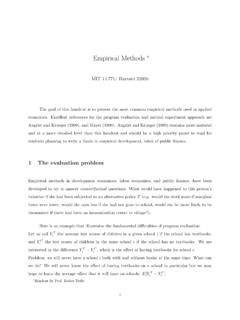Transcription of Quasi-Experimental Design and Methods - UNICEF-IRC
1 Methodological Briefs impact evaluation No. 8 Quasi-Experimental Design and Methods Howard White and Shagun Sabarwal UNICEF OFFICE OF RESEARCH The Office of Research is UNICEF s dedicated research arm. Its prime objectives are to improve international understanding of issues relating to children s rights and to help facilitate full implementation of the Convention on the Rights of the Child across the world. The Office of Research aims to set out a comprehensive framework for research and knowledge within the organization, in support of UNICEF s global programmes and policies, and works with partners to make policies for children evidence-based. Publications produced by the Office are contributions to a global debate on children and child rights issues and include a wide range of opinions. The views expressed are those of the authors and/or editors and are published in order to stimulate further dialogue on impact evaluation Methods .
2 They do not necessarily reflect the policies or views of UNICEF. OFFICE OF RESEARCH METHODOLOGICAL BRIEFS UNICEF Office of Research Methodological Briefs are intended to share contemporary research practice, Methods , designs, and recommendations from renowned researchers and evaluators. The primary audience is UNICEF staff who conduct, commission or interpret research and evaluation findings to make decisions about programming, policy and advocacy. This brief has undergone an internal peer review. The text has not been edited to official publication standards and UNICEF accepts no responsibility for errors. Extracts from this publication may be freely reproduced with due acknowledgement. Requests to utilize larger portions or the full publication should be addressed to the Communication Unit at To consult and download the Methodological Briefs, please visit For readers wishing to cite this document we suggest the following form: White, H.
3 , & S. Sabarwal (2014). Quasi-Experimental Design and Methods , Methodological Briefs: impact evaluation 8, UNICEF Office of Research, Florence. Acknowledgements: This brief benefited from the guidance of many individuals. The author and the Office of Research wish to thank everyone who contributed and in particular the following: Contributors: Greet Peersman Reviewers: Nikola Balvin, Sarah Hague, Debra Jackson 2014 United Nations Children s Fund (UNICEF) September 2014 UNICEF Office of Research - Innocenti Piazza SS. Annunziata, 12 50122 Florence, Italy Tel: (+39) 055 20 330 Fax: (+39) 055 2033 220 Methodological Brief : Quasi-Experimental Design and Methods Page 1 1. Quasi-Experimental Design AND Methods : A BRIEF DESCRIPTION Quasi-Experimental research designs, like experimental designs, test causal hypotheses. In both experimental ( , randomized controlled trials or RCTs) and Quasi-Experimental designs, the programme or policy is viewed as an intervention in which a treatment comprising the elements of the programme/policy being evaluated is tested for how well it achieves its objectives, as measured by a pre-specified set of indicators (see Brief No.)
4 7, Randomized Controlled Trials). A Quasi-Experimental Design by definition lacks random assignment, however. Assignment to conditions (treatment versus no treatment or comparison) is by means of self-selection (by which participants choose treatment for themselves) or administrator selection ( , by officials, teachers, policymakers and so on) or both of these Quasi-Experimental designs identify a comparison group that is as similar as possible to the treatment group in terms of baseline (pre-intervention) characteristics. The comparison group captures what would have been the outcomes if the programme/policy had not been implemented ( , the counterfactual). Hence, the programme or policy can be said to have caused any difference in outcomes between the treatment and comparison groups. There are different techniques for creating a valid comparison group, for example, regression discontinuity Design (RDD) and propensity score matching (PSM), both discussed below, which reduces the risk of bias.
5 The bias potentially of concern here is selection bias the possibility that those who are eligible or choose to participate in the intervention are systematically different from those who cannot or do not participate. Observed differences between the two groups in the indicators of interest may therefore be due in full or in part to an imperfect match rather than caused by the intervention. There are also regression-based, non- experimental Methods such as instrumental variable estimation and sample selection models (also known as Heckman models). These regression approaches take account of selection bias, whereas simple regression models such as ordinary least squares (OLS), generally do not. There may also be natural experiments based on the implementation of a programme or policy that can be deemed equivalent to random assignment, or to interrupted time series analysis, which analyses changes in outcome trends before and after an intervention.
6 These approaches are rarely used and are not discussed in this brief. Methods of data analysis used in Quasi-Experimental designs may be ex-post single difference or double difference (also known as difference-in-differences or DID). Main points Quasi-Experimental research designs, like experimental designs, test causal hypotheses. A Quasi-Experimental Design by definition lacks random assignment. Quasi-Experimental designs identify a comparison group that is as similar as possible to the treatment group in terms of baseline (pre-intervention) characteristics. There are different techniques for creating a valid comparison group such as regression discontinuity Design (RDD) and propensity score matching (PSM). 1 Shadish, William R., et al., experimental and Quasi-Experimental Designs for Generalized Causal Inference, Houghton Mifflin Company, Boston, 2002, p. 14. Methodological Brief : Quasi-Experimental Design and Methods Page 2 2.
7 WHEN IS IT APPROPRIATE TO USE Quasi-Experimental Methods ? Quasi-Experimental Methods that involve the creation of a comparison group are most often used when it is not possible to randomize individuals or groups to treatment and control groups. This is always the case for ex-post impact evaluation designs. It may also be necessary to use Quasi-Experimental designs for ex-ante impact evaluations, for example, where ethical, political or logistical constraints, like the need for a phased geographical roll-out, rule out randomization. Quasi-Experimental Methods can be used retrospectively, , after the intervention has taken place (at time t+1, in table 1). In some cases, especially for interventions that are spread over a longer duration, preliminary impact estimates may be made at mid-term (time t, in table 1). It is always highly recommended that evaluation planning begins in advance of an intervention, however. This is especially important as baseline data should be collected before the intended recipients are exposed to the programme/policy activities (time t-1, in table 1).
8 Timing of intervention and data collection for impact evaluations with a large sample size Pre-intervention Intervention Post-intervention t-1 Baseline t (Mid-term survey) t+1 Endline t = a specific time period 3. Quasi-Experimental Methods FOR CONSTRUCTING COMPARISON GROUPS Propensity score matching (PSM) What is matching? Matching Methods rely on observed characteristics to construct a comparison group using statistical techniques. Different types of matching techniques exist, including judgemental matching, matched comparisons and sequential allocation, some of which are covered in Brief No. 6, Overview: Strategies for Causal Attribution. This section focuses on propensity score matching (PSM) techniques. Perfect matching would require each individual in the treatment group to be matched with an individual in the comparison group who is identical on all relevant observable characteristics such as age, education, religion, occupation, wealth, attitude to risk and so on.
9 Clearly, this would be impossible. Finding a good match for each programme participant usually involves estimating as closely as possible the variables or determinants that explain the individual s decision to enrol in the programme. If the list of these observable characteristics is very large, then it becomes challenging to match directly. In such cases, it is more suitable to use PSM instead. Methodological Brief : Quasi-Experimental Design and Methods Page 3 What is PSM? In PSM, an individual is not matched on every single observable characteristic, but on their propensity score that is, the likelihood that the individual will participate in the intervention (predicted likelihood of participation) given their observable characteristics. PSM thus matches treatment individuals/households with similar comparison individuals/households, and subsequently calculates the average difference in the indicators of interest. In other words, PSM ensures that the average characteristics of the treatment and comparison groups are similar, and this is deemed sufficient to obtain an unbiased impact estimate.
10 How to apply PSM PSM involves the following five steps: 1. Ensure representativeness Ensure that there is a representative sample survey of eligible participants and non-participants in the intervention. Baseline data are preferred for calculating propensity scores. This technique can, however, also be used with endline data: the matching variables must be variables that are unaffected by the intervention. 2. Estimate propensity scores The propensity scores are constructed using the participation equation , which is either a logit or probit regression with programme participation as the dependent variable (in the programme = 1, not in the programme = 0). The characteristics deemed to affect participation should be well considered and as exhaustive as possible, but should exclude characteristics that may have been affected by the intervention. For this reason, it is best to use baseline data, where available, to estimate the propensity scores.
